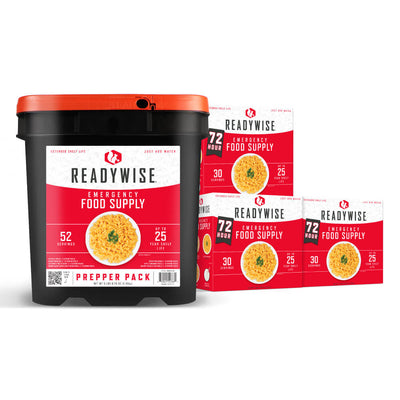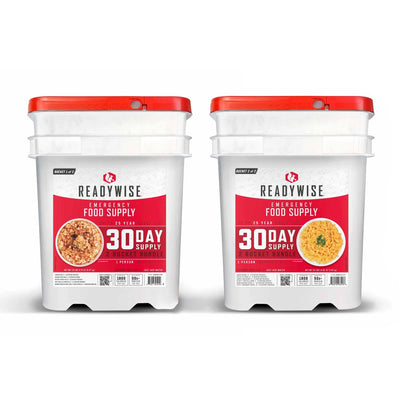How To Create Extra Space for Food Storage
If you’re living in an apartment or small house, finding the room for food storage can be a little tricky. And if you have kids, the problem compounds even more. What little space you have shrinks exponentially. But don’t give up hope! With a little creativity and some emergency food storage ideas, there are likely some underutilized spaces in your home, that can easily be re-purposed for some extra food storage.
Importance of Proper Food Storage
In today's unpredictable world, having a well-stocked food supply isn't just a convenience—it's a necessity. Emergencies can strike without warning, and being prepared can make all the difference. Proper food storage ensures that you and your family have access to essential nourishment during unforeseen events. By utilizing these creative storage solutions, you're taking proactive steps toward self-sufficiency and peace of mind. Plus, you might be wondering how much emergency food should I have—a good rule of thumb is to store enough for at least two weeks, ensuring your family’s well-being during unexpected situations.
14 Places You Can Store Extra Food
-
Create False Bottoms in Cupboards:
If you have low cupboards in the kitchen or other areas in the house, creating a false bottom allows you to create additional long term food storage. Just layer the floor with boxes or containers of the same height, and then cover with a piece of wood, to create your new “faux floor.”
-
High Shelves in Children’s Closets:
If your kids can’t reach the high shelves in their closets, this area is likely going underutilized. Store some food on these! Alternatively, some people opt for a false floor in kids' closets, and storing emergency food supply on the ground level. If long term food storage is within reach however, it’s more likely to be played with, moved around, or climbed on.
-
Moving Spices to Racks On Cupboard Doors:
Many people have freed up some valuable cupboard space by creating a spice rack on the inside of a cupboard door. Purchase a lightweight rack that can be fastened on the inside of the cupboard door, then transfer your spices to it. This allows your main cupboard area to be open for storage like canned goods and dried food. Spice racks can be fastened inexpensively with pegboard, Velcro, or even magnets!
-
Furniture That Has Built-in Space:
Some storage containers are purpose-built to be decorative. These are wicker baskets, chests, hollow footstools, and over sized vases and urns that would otherwise remain empty. Fill them full of non perishable food, and never notice the difference!
-
Space Above Kitchen Cupboards:
Many people have a couple feet of awkward and unused space in their kitchens, between the tops of their cupboards and the ceiling. This space is ideal for extra storage. To avoid adding extra weight, the best things to store on top of the cupboards are light things like soup mixes, dry ingredients, and cereals.
-
In or Around Furniture:
Pull your furniture out from the wall, and store food in the space created behind them. You can then hide the space with a simple fabric covering, table top, or other guise of your choosing. To get even more creative, how about making your own “food storage entertainment center” out of boxes or buckets? Stack them and then drape with fabric.
-
Below Stairways:
Create some simple shelving in the awkwardly shaped storage space under the stairs, and cash in big time! Under the stairs works great for cans, and other items that are small enough to fit in versatile spaces. Some houses will even have this space already converted into shelving and “ready-to-use” storage.
-
Cupboards above the Fridge:
Just like the space above your kitchen cupboards, the cupboards above your fridge are often overlooked. They’re hard to reach, so they’re frequently forgotten about, or used only as a catchall. Bingo! To go even further, take the doors off of those cupboards, and store food on top of the fridge in front of them as well. Cover the whole area with a fabric curtain, and call it a day.
-
The Laundry Room:
“Back of house” areas like the laundry room work great. The nice thing about them is that they are out of sight, and don’t have to be pretty. Stack dried food and non perishable food along a wall, use empty cupboards, or any other way you want to fit in what you can. If your laundry room has an emergency floor drain, it could be a good place to store water as well.
-
Under the Bed:
This is one of the first places people think to store extra food, and rightfully so! There are a lot of different ways you can do it. You can line the perimeter with boxes or buckets of non perishable and perishable food. Or to get even more involved, you can incorporate a rotating food system, by storing food in rows running underneath your bed, with the oldest items coming out on one side, and new ones being put in on the other.
-
Suitcases and Luggage:
Unless you’re a constant jet-setter, stored luggage and suitcases can make a GREAT place to store extra food. Suitcases are usually modular, so they will take up the same amount of total space whether they are full or not. Fill these guys up with your non-perishables! Mylar pouches work particularly well for the area inside a suitcase. And hey, if you forget and leave some food in your suitcase, you already have the first meal after you land.
-
Attics and Crawl Spaces:
Although these locations shouldn’t be your first choice, they are worth thinking about. These areas can be subject to extreme temperatures, moisture, critters, and limited access, but could still work out great for non-foods: toilet paper, sanitation supplies, paper towels, toothbrushes, first aid, deodorant, and more.
-
Elevate Your Bed on Blocks:
Lifting your bed on blocks to create extra space is an “oldie but goodie.” College kids all over the world know this trick! Although you should be careful, lifting up your bed can double the space you have (or more!). Cinder blocks are really cheap, and readily available. They’re cheap, so knock yourself out.
-
Standalone Storage Locker:
If you’ve already maximized the space inside your home, an outside locker is worth thinking about. These are the upright units that hold a ton, and can be propped against the house, in a carport, or anywhere else. Even though keeping your food outside isn’t ideal, it’s better than nothing! Just be sure to get a locker that weathers well. And they can be a little spendy, so if possible, see if you can get one in your local classifieds.
There you have it, 14 ideas to increase the storage areas you have available for food storage. A couple of final reminders:
- Keep the “longest term” food storage away the deepest. These are the items that you will rarely use, and don’t need to be readily accessible.
- Most importantly, be real about your food storage. If stuffing your living room furniture with food storage meals isn’t something you can stomach, don’t do it. If lifting your bed up on blocks bugs you every time you go to sleep, it’s not worth it. An occasional nuisance here and there isn’t going to kill you, but on the whole, preparing for emergencies should not be something that makes you miserable.
Organizing and Rotating Your Food Supply
Finding space is only half the battle; keeping your food organized is just as important. Start by labeling all your items with purchase or expiration dates. This makes it easy to practice the "first in, first out" method, where you use older items before newer ones. Consider creating an inventory list to keep track of what you have and what needs replenishing. Regularly check your stash to rotate items and ensure nothing goes to waste.
Food Safety Considerations
While getting creative with long term storage, don't overlook food safety. Make sure the areas you choose are cool, dry, and dark to prolong shelf life. Avoid places prone to temperature fluctuations or moisture, like attics or uninsulated garages. Use airtight containers to protect against pests and contaminants. Remember, proper storage conditions are crucial for maintaining the quality and safety of your food supply.
The places you can store additional food definitely aren’t limited to this list. Get creative and have fun!
For additional food storage ideas like these, check out The Average Joe Prepper’s Guide to Emergency Food Storage, from The Daily Prep.
Take the Next Step in Your Emergency Preparedness
Creating extra space for food storage is just the beginning of your emergency preparedness journey. With the right storage solutions and a well-organized supply, you’ll feel confident knowing you’re ready for anything. Whether you’re stocking up for an unexpected event or planning for the long term, having enough food on hand is key to keeping your family safe and secure.
Ready to take your preparedness to the next level? Explore more expert tips and a wide range of long term emergency food supplies at ReadyWise, and ensure you’re always prepared for whatever comes your way!
















































































